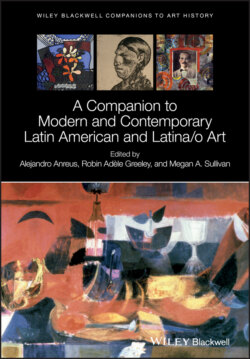Читать книгу A Companion to Modern and Contemporary Latin American and Latina/o Art - Группа авторов - Страница 53
Notes
Оглавление1 1 The words modernism and modernist avant‐garde refer to artistic and literary movements associated with (much debated) aesthetic experimentation, whereas modernity describes a historical condition with (much debated) characteristics including urbanization, secularization, “progress,” and mechanization of labor. Modernism, modernity, and avant‐garde do not translate easily between English, Spanish, and Portuguese. In Spanish America, the word used to designate experimental artistic and literary movements is vanguardia (avant‐garde), whereas the parallel and contemporaneous movement in Brazil is called modernismo (modernism). Spanish modernismo refers to late‐nineteenth‐century poetry movements – the very generation against which the vanguardia proclaimed its rebellion – that are known for an “art for art's sake” aesthetic philosophy.
2 2 For more on the modern‐colonial system, see Quijano, A. (1991). Colonialidad, modernidad/racionalidad. Perú Indígena 13 (29): 11–29; Quijano, A. and Wallerstein, I. (1992). Americanity as a concept, or the Americas in the modern world‐system. International Journal of Social Sciences 134: 549–557.
3 3 For a full discussion of errancy, upon which this essay builds to look beyond the original cases of Mexico and Brazil, see my Errant Modernism: The Ethos of Photography in Mexico and Brazil (Gabara 2008).
4 4 Renaissance perspective is the sixteenth‐century technique of representation that creates the illusion of depth in a two‐dimensional frame.
5 5 “Aesthetic regime” is a phrase used by French theorist Jacques Rancière (2004) to describe and intervene in the categories that govern art history and museum collections.
6 6 Brazilian Roberto Schwarz's reflections on “ideas out of place” were influential in my development of a theory of modernist errancy. See my analysis of Mário de Andrade's photograph, “Accidental desvairismo / question of a boat [lancha] and / of lunch [English original] / June 7, 1927,” in Errant Modernism. Many of the photographs can be seen on the website created for an exhibition presenting the vast range of his scholarly and artistic production: http://oficinasculturais.org.br/mariodeandrade.
7 7 For more on photography and US expansionism in the Spanish–American War, see my “‘Cannon and Camera’: Photography and Colonialism in the Américas,” ELN 44(2) (2006): 45–64.
8 8 The Casasola Archive has been mostly digitized, and can be searched at http://sinafo.inah.gob.mx/coleccion‐archivo‐casasola/.
9 9 I borrow this phrase from and ground my analysis in Rita Felski's (1995) important study, The Gender of Modernity.
10 10 See Borges (1986), Textos cautivos, and (2000) Borges en El Hogar.
11 11 Although feminism's critique of the objectification of the female body in art history should not be undermined, recent studies have revealed ongoing disruptions in authority of the male gaze. See for instance Felter‐Kerley, L. (2010). The art of posing nude: models, moralists, and the 1893 Bal des Quat'z‐Arts. French Historical Studies 33 (1): 69–97. For an in‐depth discussion of what a model does, see Steiner, W. (2010). The Real Real Thing: The Model in the Mirror of Art. Chicago: University of Chicago Press; Steiner writes, “The model functions not only as an artwork, but as a quasi artist too, and sometimes as an artist tout court” (p. 22).
12 12 For more on this, see my Errant Modernism.
13 13 For more on the position of Chambi among indigenistas, see Coronado, J. (2009). The Andes Imagined: Indigenismo, Society, and Modernity Illuminations: Cultural Formations of the Americas series. Pittsburgh: University of Pittsburgh Press, and Scorer, J. (2014). Andean self‐fashioning: Martín Chambi, photography and the ruins at Machu Picchu. History of Photography 38 ( 4): 379–397.
14 14 Like his contemporaries, Chambi worked as a graphic correspondent for the weekly illustrated magazine Variedades (1918–1927) and the daily newspaper La Crónica taking pictures at weddings and political celebrations and parties, as well as the images accompanying Aspectos pintorescos de la vida del indio published in La Crónica in 1924, a text written by a Lima correspondent sent to Cusco (Schwarz 2007, p. 40). Between 1918 and 1929, Chambi published 352 signed pictures, and around 70 photographs that can be attributed to him, in 67 issues of Variedades and 59 of La Crónica (Schwarz 2007, p. 42).
15 15 The debates over the image world of Chambi has been fierce, perhaps most clearly reflected in the essay by Jorge Heredia in which he performs a devastating analysis of essays by Spanish critics and the role of the Chambi family that controls the archive in granting them access and rights for his images. Heredia concludes with a warning the Spaniards should “conocer ese verso de Vallejo ‘cuídate España de tu propia España’, el cual quizás le pueda dar un mejor punto de vista para entender a Latinoamérica” [know that verse by Vallejo: “Spain, take care of your own Spain,” which perhaps can give the best point of view to understand Latin America]. Jorge Heredia, “Martín Chambi,” http://www.bradanovic.cl/chambi.html (accessed 8 September 2013, no longer active). Article based on a review written for the journal Perspektief (Rotterdam 1992).
16 16 Beatrice Hanssen (1999) calls this Benjamin's ambivalence regarding the aura of old photographs: his melancholic attachment to them despite his derision of their attempt to be “artistic” rather than embrace the medium's potential for mass reproduction.
